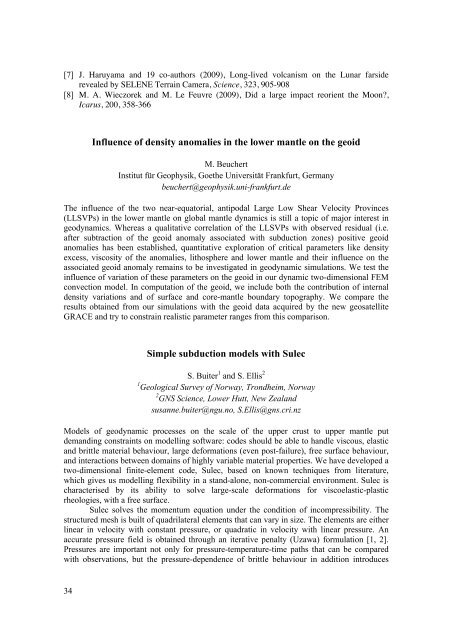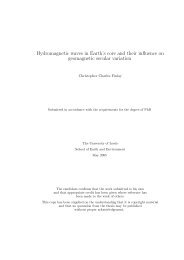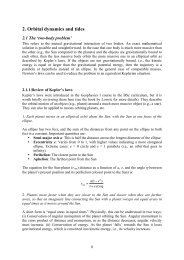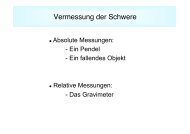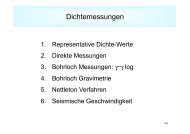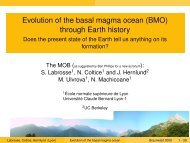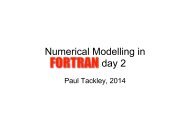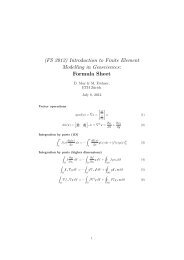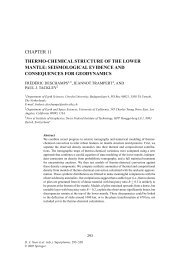[7] J. Haruyama and 19 co-authors (2009), Long-lived volcanism on the Lunar farsiderevealed by SELENE Terrain Camera, Science, 323, 905-908[8] M. A. Wieczorek and M. Le Feuvre (2009), Did a large impact reorient the Moon?,Icarus, 200, 358-366Influence of density anomalies in the lower mantle on the geoidM. BeuchertInstitut für Geophysik, Goethe Universität Frankfurt, Germanybeuchert@geophysik.uni-frankfurt.deThe influence of the two near-equatorial, antipodal Large Low Shear Velocity Provinces(LLSVPs) in the lower mantle on global mantle dynamics is still a topic of major interest ingeodynamics. W<strong>here</strong>as a qualitative correlation of the LLSVPs with observed residual (i.e.after subtraction of the geoid anomaly associated with subduction zones) positive geoidanomalies has been established, quantitative exploration of critical parameters like densityexcess, viscosity of the anomalies, lithosp<strong>here</strong> and lower mantle and their influence on theassociated geoid anomaly remains to be investigated in geodynamic simulations. We test theinfluence of variation of these parameters on the geoid in our dynamic two-dimensional FEMconvection model. In computation of the geoid, we include both the contribution of internaldensity variations and of surface and core-mantle boundary topography. We compare t<strong>here</strong>sults obtained from our simulations with the geoid data acquired by the new geosatelliteGRACE and try to constrain realistic parameter ranges from this comparison.Simple subduction models with SulecS. Buiter 1 and S. Ellis 21 Geological Survey of Norway, Trondheim, Norway2 GNS Science, Lower Hutt, New Zealandsusanne.buiter@ngu.no, S.Ellis@gns.cri.nzModels of geodynamic processes on the scale of the upper crust to upper mantle putdemanding constraints on modelling software: codes should be able to handle viscous, elasticand brittle material behaviour, large deformations (even post-failure), free surface behaviour,and interactions between domains of highly variable material properties. We have developed atwo-dimensional finite-element code, Sulec, based on known techniques from literature,which gives us modelling flexibility in a stand-alone, non-commercial environment. Sulec ischaracterised by its ability to solve large-scale deformations for viscoelastic-plasticrheologies, with a free surface.Sulec solves the momentum equation under the condition of incompressibility. Thestructured mesh is built of quadrilateral elements that can vary in size. The elements are eitherlinear in velocity with constant pressure, or quadratic in velocity with linear pressure. Anaccurate pressure field is obtained through an iterative penalty (Uzawa) formulation [1, 2].Pressures are important not only for pressure-temperature-time paths that can be comparedwith observations, but the pressure-dependence of brittle behaviour in addition introduces34
feedback relations to the mechanical flow. Material properties are carried on tracer particlesthat are advected through the Eulerian mesh. Elasticity is implemented following the approachof Moresi et al. [3], which involves an adjustment of the viscosities, the addition of a forceterm, and storing stresses and their rotations on the tracers. Brittle materials deform followinga Mohr-Coulomb criterion. Brittle stress is kept at the yield value by iterating on an adjustedeffective viscosity [see for example 4]. The final effective viscosities are averaged in tracer toelement averaging schemes (harmonic, arithmetic or geometric) [5]. The top boundary of ourmodels can be a free surface on which simple surface processes models may be imposed. Thefree surface is obtained by small adjustments of the Eulerian mesh.We first show examples of simple models of upper crustal brittle deformation, elasticrecovery and viscous flow. We then build on these to derive simple models of ocean-continentsubduction, focussing on the near-surface behaviour.References[1] C., Cuvelier, A. Segal and A. A. van Steenhoven (1986), Finite element methods and Navier-Stokes equations, D. Reidel Publishing Company, Dordrecht, Holland, 483 pp.[2] D. Pelletier, A. Fortin and R. Camarero (1989), Are FEM solutions of incompressible flows reallyincompressible? (Or how simple flows can cause headaches!), Int. J. Num Meth. in Fluids 9, 99-112.[3] L. Moresi, F. Dufour and H.-B. Mühlhaus (2003), A Langrangian integration point finite elementmethod for large deformation modeling of viscoelastic geomaterials, J. Comp. Phys. 184, 476-497.[4] V. Lemiale, H.-B. Mühlhaus, L. Moresi and J. Stafford (2008), Shear banding analysis of plasticmodels formulated for incompressible viscous flows, Phys. Earth Planet. Int. 171, 177-186,doi:10.1016/j.pepi.2008.07.038[5] H. Schmeling, A. Y. Babeyko, A. Enns, C. Faccenna, F. Funiciello, T. Gerya, G. J. Golabek, S.Grigull, B. J. P. Kaus, G. Morra, S. M. Schmalholz and J. van Hunen (2008), A benchmarkcomparison of spontaneous subduction models—Towards a free surface, Phys. Earth Planet. Int.171, 198-223, doi:10.1016/j.pepi.2008.06.028Dynamics and implications of slab detachment due to ridge-trench collisionE.R. Burkett and M.I. BillenUC Davies, USAerburkett@ucdavis.eduThe approach of a buoyant spreading ridge to a subduction zone may lead to detachment of asubducted slab. Previous work has called upon the detachment process as an explanation forobserved ridge abandonment and slab-window related magmatism (e.g. in Baja CA/westernMexico), but such a scenario has not been tested using fully-dynamic numerical models. Weuse dynamic two-dimensional models including a non-Newtonian rheology to study theapproach of a spreading ridge to a subduction zone. In models exploring effects of subductedslab length, distance of the ridge from the trench, shear zone strength, and lithospheric yieldstrength, we find the following dynamics of ridge approach: (a) a decrease in subductionvelocity as the ridge approaches the trench, (b) a shrinking surface plate that maintains auniform subduction velocity, (c) ridge abandonment distances 100-275 km from the trench,and (d) slab gap distances 195-285 km from the trench. These results are consistent withobservations in Baja CA, w<strong>here</strong> detachment of the Cocos slab may explain abandonment ofobserved segments of the East Pacific Rise 50-200 km outboard of the trench (Lonsdale,35
- Page 4 and 5: !!!!!!!!!!!!!!!!!!!!!!!!!!!!!!!!;00
- Page 7 and 8: *@/(%/:(#5*A*2$'5*=(),!/'//*+&!>!9'
- Page 9 and 10: What drives plates? What drives pla
- Page 11 and 12: @+/#'(!M'//*+&!K!>!1)&#,'!2:&);*7/!
- Page 13 and 14: !!!!!!!DE:-"#F-:***G/5%9-/*+H/#I/":
- Page 15 and 16: interact. Therefore, we still face
- Page 17 and 18: Development of efficient numerical
- Page 19 and 20: Multi-scale methods for flow and tr
- Page 21 and 22: The dynamics of magma in a convecti
- Page 23 and 24: Evolution of the basal magma ocean
- Page 25 and 26: separation of metal and silicates i
- Page 27: I’ll show our recent model of loc
- Page 30 and 31: Coseismic subduction zone strain-re
- Page 32 and 33: plumes persist throughout the model
- Page 34 and 35: ReferencesT. V. Gerya, et al. (2000
- Page 36 and 37: depth) and proposed a group of best
- Page 40 and 41: 1991) and the presence of non-arc r
- Page 42 and 43: Discussion on resolving sediment su
- Page 44 and 45: must be simulated at the correct vi
- Page 46 and 47: 0.3) buoyancy ratios induce stable
- Page 48 and 49: set up is similar to the experiment
- Page 50 and 51: e transported down and stored in th
- Page 52 and 53: Subduction stress accumulation and
- Page 54 and 55: axisymmetric octahedral cubicmode (
- Page 56 and 57: advection, cross-sectional area, nu
- Page 58 and 59: Continental deformation along the C
- Page 60 and 61: schemes: upwind differences, higher
- Page 62 and 63: Reconstructing the past thermal evo
- Page 64 and 65: this study, we examine parameter se
- Page 66 and 67: within it, in the cold lithospheric
- Page 68 and 69: investigate in more detail the conc
- Page 70 and 71: Alaska that include the overriding
- Page 72 and 73: ehavior in the direction of trench
- Page 74 and 75: Modelling mantle dynamics and crust
- Page 76 and 77: Upper mantle convective instability
- Page 78 and 79: Investigating the physical properti
- Page 80 and 81: influence of a NW push by the Adria
- Page 82 and 83: parameters. The thermomechanical mo
- Page 84 and 85: Core mantle boundary topography as
- Page 86 and 87: considering the bending northern pa
- Page 88 and 89:
migration rates similar to the half
- Page 90 and 91:
Length-scale of compressible mantle
- Page 92 and 93:
The effects of glacial loading on l
- Page 94 and 95:
[4] A. Mohsen, R. Hofstetter, G. Bo
- Page 96 and 97:
either with imposed plate motions (
- Page 98 and 99:
is coupled to the mechanical one in
- Page 100 and 101:
ecognized with some confidence in t
- Page 102 and 103:
A benchmark study of mantle convect
- Page 104 and 105:
Figure: Correlation of predicted dy
- Page 106 and 107:
Figure 1. Planetary models using St
- Page 108 and 109:
Geodynamic modeling of terrane accr
- Page 110 and 111:
Longitude: Linking Earths ancient s
- Page 112 and 113:
Transitions in tectonic mode based
- Page 114 and 115:
Delamination takes place only in a
- Page 116 and 117:
jump on the pattern of flow are exp
- Page 118 and 119:
Alpert, Lisa Ann (laalpert@usc.edu)
- Page 120 and 121:
Hieronymus, Chris, Dr. (christoph.h
- Page 122 and 123:
Schmalholz, Stefan Markus, PD Dr. (


